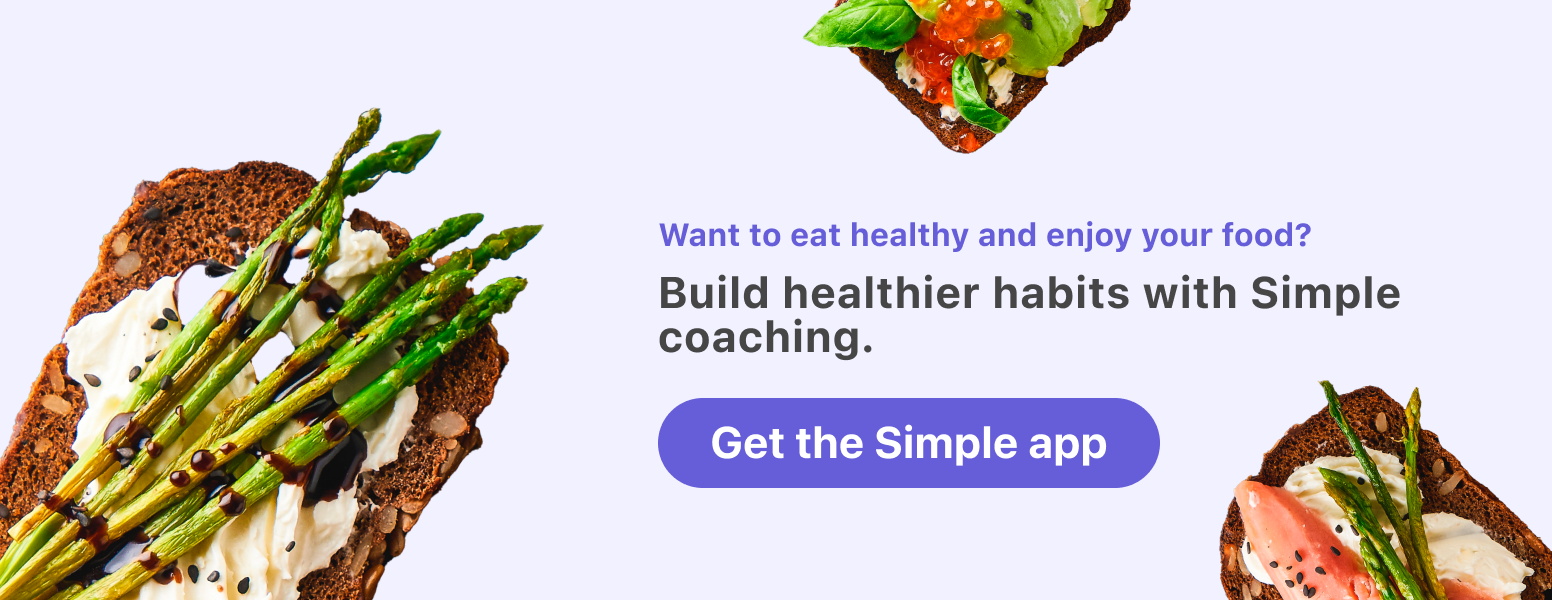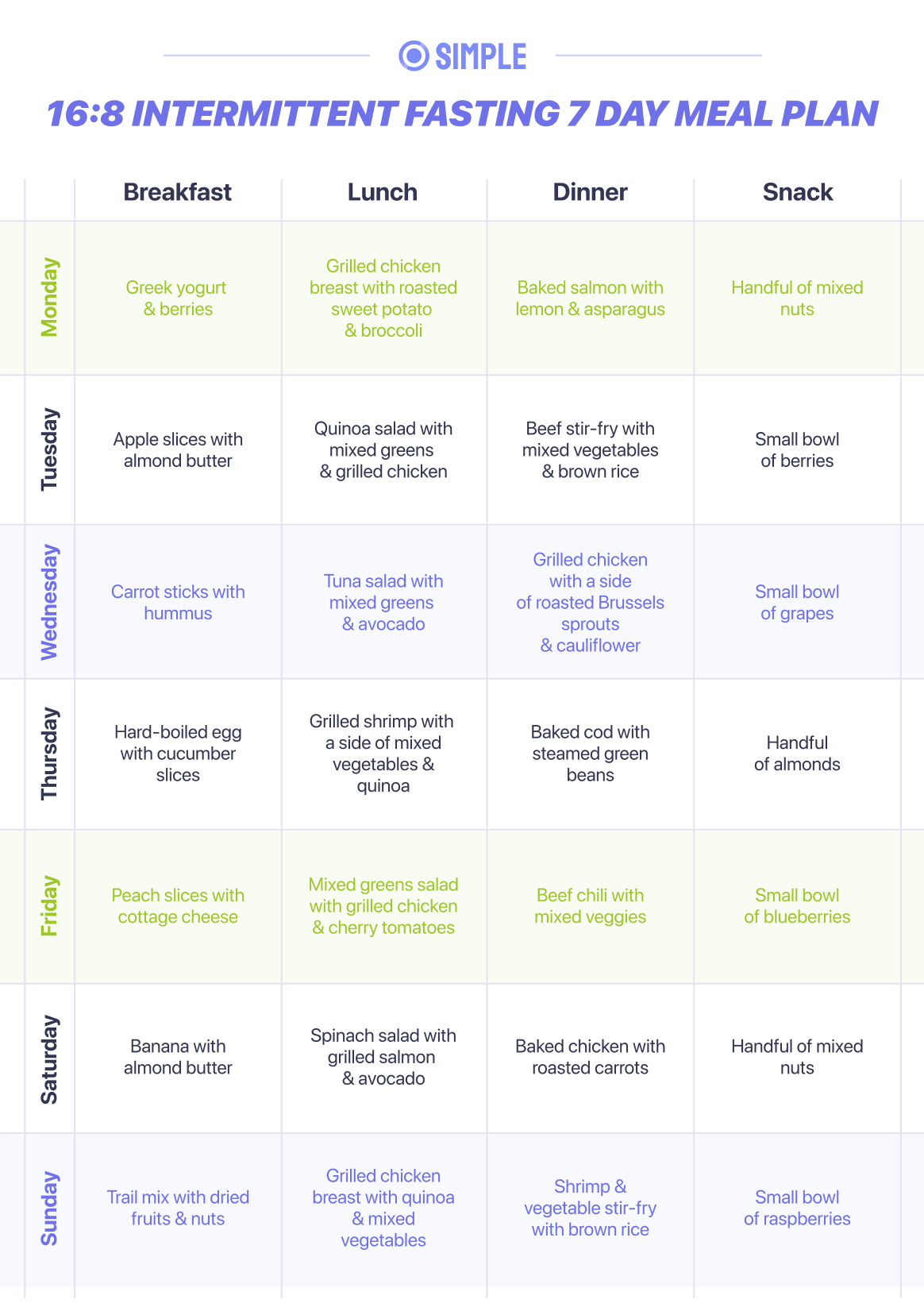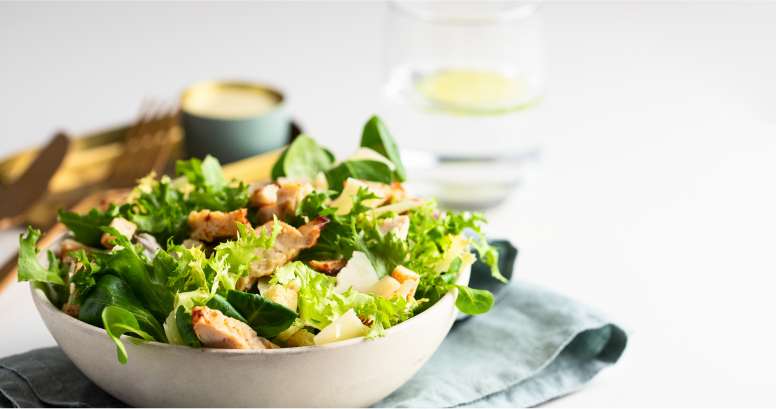
Fact checked Before we hit “publish,” our science team needs to be 100% satisfied that we’re giving solid advice based on high-quality, reliable, scientifically-sound research.
Editorial guidelines At Simple, we use our nutrition and wellness expertise to give you actionable content that helps you achieve your goals, overcome challenges, and increase your well-being.
Table of contentsScience tells us that intermittent fasting can help us shed pounds and improve our health in the process.
But let’s be real. To unlock the full benefits, we need more than just fasting. We need guidance on what to eat and the ability to hit those high-quality food choices more often than not.

With that in mind, let’s talk about how to kick butt at 16:8 intermittent fasting with a well-constructed, goal-aligned, health-promoting, 7-day meal plan.
We’ll dive into what 16:8 intermittent fasting is all about and how to write a meal plan that can take your intermittent fasting results to the next level.

Having a meal plan that takes out the guesswork around what to eat during intermittent fasting can be the difference between hitting your goals and not. It can also help avoid any “intermittent fasting not working” moments of dismay.
So we thought to ourselves, how can we help here? We can teach you how to write an intermittent fasting meal plan, of course, but could we do better? This is what we came up with:
A satisfying, balanced, easy-to-follow 16:8 intermittent fasting 7-day meal plan that does all the thinking for you so you can simply focus on prepping and eating!
Following this intermittent fasting 16:8 meal plan will not only make it easier to stick to your new fasting schedule, but it will also ensure that you are properly fueling your body.
You can also check out our guide on what you can drink while fasting to make sure you’re staying hydrated.

Let’s be clear, this is simply an initial blueprint for you to customize to your tastes. Feel free to make adjustments as you learn what you like and don’t like, what keeps you full, what’s easy to prepare, and so on. For example, if:

First off, let’s briefly cover what to eat during the fasting window by learning what breaks a fast. Here’s the TL;DR version: Anything with calories breaks a fast. So what should you eat during the fast itself? Nada. (Calorie-free beverages are very much your friend here.)
Now, let’s think about what to put into your meal plan for the eating window to help you hit your goals as well as feel and perform at your best. To get the most from the 16:8 schedule of intermittent fasting, include the following in your 7-day meal plan:
Apples, bananas, berries, oranges, peaches, pears, etc. These foods provide essential vitamins, minerals, and fiber that help keep your gut happy and boost your health.
Broccoli, cauliflower, cucumbers, carrots, leafy greens, etc. These foods are low in calories and high in nutrients, particularly fiber, that help keep you feeling satisfied for longer.
Chicken, fish, turkey, tofu, etc. Packed with essential amino acids, these foods help you build and repair muscle tissue, in addition to keeping you feeling full.
Brown rice, quinoa, whole wheat bread, etc. These complex carbohydrates will provide you with sustained energy, helping you curb hunger pangs and stay satisfied for longer.
Avocado, nuts, seeds, olive oil, etc. Chock full of monounsaturated fats and omega-3 fatty acids that help reduce inflammation and improve health.
Live yogurt, kefir, cheese, cow’s milk, fortified plant-based milks, tofu, etc. These are great sources of calcium, which is key for keeping our bones strong. Calcium is important at all ages, but especially when trying to lay the foundations of bone mass throughout our 20s and for women in their 50s and beyond.[1]
You’ll notice these foods running through the 16:8 intermittent fasting 7-day meal plan PDF we shared with you earlier.
When you’re new to fasting, it’s easy to fall into some classic intermittent fasting mistakes, like making food choices that trip you up or eating more than you need due to oversized hunger.
If this happens to you, no sweat! We’ve all been there. Over time, so long as you get to know which foods don’t help you reach your goals, it becomes easier to eat less of them.
Some of the usual goal-thwarting suspects include:
Nothing is off-limits, and we’re certainly not here to tell you what you can and can’t eat. This is simply a list of foods that often get in the way of goals like losing weight. If you can, aim to eat these foods less often, and your results will likely speed up.
As we’ve seen, intermittent fasting on a 16:8 schedule involves abstaining from food for 16 hours and eating within an 8-hour window.
How you schedule this is completely your call. Want to have your last meal at 6 PM and breakfast at 10 AM the next day? Cool. Or maybe you’d prefer to eat dinner later, say 8 PM, and fast till the following midday. Whatever works for you works.
When you’re eating as normal, your body breaks carbohydrates down into glucose, which is your main source of energy. When you fast, though, your body burns through your stored glucose, and so it has to switch to using your fat stores instead. This process of burning fat for energy is called ketosis. How long it takes to reach ketosis is different for everybody, but fasting for 16 hours gets most people there.
By eating your meals in a shorter window, you also have less time to eat your usual amount of food. Maybe that after-dinner snack gets skipped, and over time, your hunger and fullness cues adjust to be satisfied with smaller meals.
The 16:8 fasting schedule is well studied, and there’s a fair amount of evidence to show that intermittent fasting this way can have some positive effects.
If all these benefits have you itching to start your intermittent fasting journey, take our Simple quiz and get started today!
As with anything in life, there are some risks to be aware of, and as with any intermittent fasting schedule, 16:8 intermittent fasting may cause intermittent fasting side effects.
You may experience:
The good news is that these side effects are par for the course when you’re getting started, but they will calm down. (Especially if you’re being consistent.) You can also lower your risk of potential side effects by staying hydrated and ensuring you’re eating nutrient-dense foods during your eating windows. This is exactly where a well-put-together meal plan can help!

Whether intermittent fasting is right for you — and your body, goals, preferences, and lifestyle — depends on lots of factors. It may also involve some experimentation before you figure out what works for you (and if it does at all).
For example, if you’re a newcomer to intermittent fasting, even with a supersonic meal plan, maybe fasting for 16 hours is a stretch too far. Instead, try reading up on intermittent fasting for beginners and starting with a lighter schedule, like 12-hour intermittent fasting.
On the other hand, if you’re already into intermittent fasting and looking for more of a challenge, you could try following an 18:6 intermittent fasting schedule.
Before you make any changes, though, you should always check with your primary care provider because intermittent fasting isn’t the right fit for everyone. You should be especially cautious if you:
(Psst! We also don’t ever recommend fasts longer than 18 hours or schedules like Eat Stop Eat, water fasting, and OMAD. These intermittent fasting schedules are very restrictive and don’t lead to better results.)
Learning how to meal plan can feel like a daunting task. Making a 7-day meal plan that works for intermittent fasting even more so. It’s not something we learn at school, huh?
That’s OK. You can get started with intermittent fasting using the meal plan for 16:8 we gave you. Once you’re in the swing of things, use these tips to help you meal plan for success.
Sometimes, we focus so much on the food that we forget to drink! Just as you would explore what you like to eat and which foods make you feel good — do the same with drinks.
For some, a couple meals a day works great. For others, spreading their food out over three meals and a snack or two is ideal. Find what works for you and plan accordingly.

Your meals don’t have to be the same every day or every week. Unleash your creative side, try some recipes, and add some spice to your life!
Every solid meal plan has some staple meals and snacks in rotation — it doesn’t always have to be about being creative and different. Find the meals you love, the recipes you can cook blindfold, and the easy grab-and-go snacks for busy days and pepper them into your meal plans.
Part of winning at meal planning is having your food-prep steps factored into your life. Book some time in your calendar to plan, shop, and prep what you need.
If you’re ready to try something new to hit your health / weight loss goals, 16:8 intermittent fasting may be just the solution you’ve been looking for.
And, if you add meal planning to the mix, you can take it to the next level.
Limiting your eating window to eight hours a day and packing your diet full of nutritious, delicious food gives you a double whammy of both burning fat and optimizing your health.
If you’re curious to give it a try, take our Simple quiz and get started today!
How much weight you can lose with 16:8 intermittent fasting in a week comes down to various factors like your current weight, lifestyle, food choices, activity level, and so on. On the whole, shooting for around 1 to 2 lbs per week is a safe bet.
On a 16:8 fasting meal plan, you can eat whatever you want. That said, we recommend health-promoting, nutrient-rich whole foods to keep you satisfied, energized, and feeling good.
How to lose weight in 7 days with intermittent fasting: aim to lose a pound or two, make healthful food choices, and move your body. To get more of a handle on this, check out our guide to fat loss vs. weight loss.
You can eat as many meals as you want while 16:8 fasting — it’s all about finding what works best for you and your goals.
Yes, you can eat whatever you want after 16 hours of fasting. That said, it’s important to ensure your body gets all the nutrients it needs. So, go ahead and enjoy your favorite foods, but be sure to include plenty of fruits, vegetables, and protein, too!
